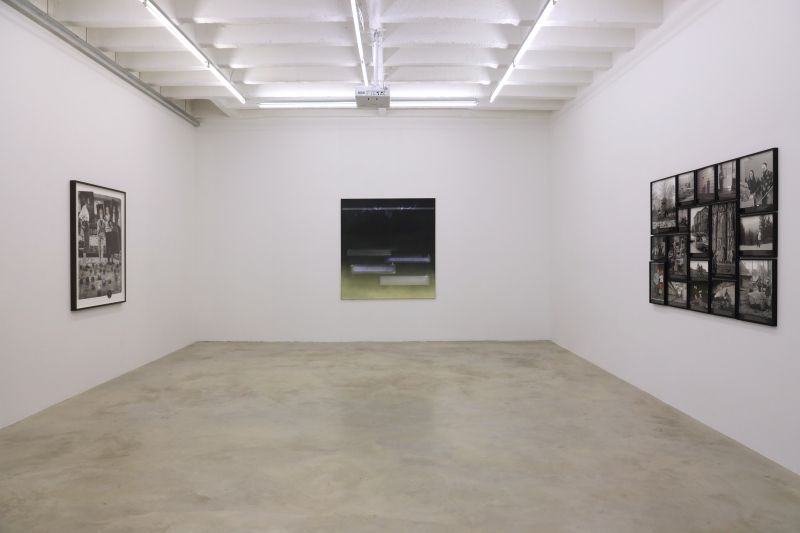Ulla Jokisalo | Katarzyna Kozyra | KwieKulik | Dominik Lejman | Santeri Tuori
Opening: Friday, 3 March 2023, 6 – 8 pm
Exhibition: 3 March – 22 April 2023
Venue: Persons Projects, Lindenstr. 34, 10969 Berlin
Persons Projects is proud to present a group exhibition, The Veneer of
Happiness. The show focuses on the various myths and stereotypes
associated with how success equates with happiness. These collected
works exemplify the art of observing and displaying various states of
happiness through altered realities from different perspectives: While
Dominik Lejman and Katarzyna Kozyra share a common interest in
challenging common concepts of beauty, we experience another perspective
in the work of KwieKulik and Ulla Jokisalo whose works question and
confront how western culture bends reality to fit certain norms or
expectations in politics, economics or gender that define our presumed
narrative for what happiness should look like.
35 Minute Smile (2002) by Santeri Tuori dares the viewer to engage with the artist as he performs an unnatural act of smiling that transforms the theatre of being happy into a mere facial façade. The artist enters the picture very seriously and focused, and then begins to smile at the viewer – a possible reminiscence of taking yearbook pictures at school. Soon, the video appears to be frozen, but in reality, the artist is smiling continuously. The smile is – if not malicious, but slightly strained – hung between action and expression, evoking a sense of madness. Here, the usual brief moment of smiling lasts for 35 minutes. It ends when the artist can no longer hold his facial expression and walks away, leaving us with an impression of unease.
Katarzyna Kozyra, Poland's most well-known female video artist, has been breaking social taboos from the very beginning of her career, for which the conservative Polish society regards her as controversial. Her video Cheerleader (2006) was a part of the extensive project In Art Dreams Come True which started during her scholarship at DAAD Berlin. The work was conceived as a music video clip to Gwen Stefani’s song "What You Waiting For?". The scenes unfold in a men's locker room, evoking clichés of femininity and masculinity. In the beginning, the young, fit men do not pay the slightest attention to Kozyra, the attractive, singing and dancing cheerleader. But when she reappears in her nude, obese female opera singer costume, the thong-clad athletes stand at full attention. The video explores the problems our culture has with identity and the use of our bodies as mere costumes for superficial expressions of integrity.
KwieKulik is an artistic duo consisting of Zofia Kulik and Przemysław Kwiek, who were active between 1971 and 1987. Within the frame of this cooperation, they carried out actions and interventions, constructed installations and objects, and worked with texts, films, slides, and mail art. Their work Ameryka (1972) is a persiflage of the magazine with the same title that was distributed in Poland by the US-American Embassy to present the leading ideas and opinions about social, political, economic, and cultural issues in the US. Looking through the magazine, KwieKulik was intrigued by the images of happy people and the effectiveness of problem-solving as an example of success. This series of photographs represented an ideal of reality based on the duo’s own image of the American Dream, showing them as happy parents who travel the world and have succeeded in their careers. Despite mocking the aesthetics of Ameryka, the photographic collage creates an image typical of all propaganda, thereby further helping to mythologize the American Dream for foreigners who envy the political system and freedom of the US.
Ulla Jokisalo spent her youth growing up in Finland in quiet surroundings on the edge of a forest. Her mother, who was a seamstress, would bring her the latest fashion magazines on her return from foreign trips. From early childhood, Jokisalo would cut out characters from these popular magazines, using them as friends to play with, as well as models of beauty. In her work, she explores the various ways in which these childhood memories and experiences influenced our personalities and perception of the world as a central theme. Sometimes playful, other times scary, she circles around fate, memory, and the notion of time. In Tableau (2021), a work from the series The Collection of Headless Women, Jokisalo cleverly juxtaposed typical childhood memories with a portrayal of adulthood: Based on black and white photographs of four female figures playing boules, the artist added four smaller photographs of doll heads that cover the faces of the women in the original photograph. In front, the artist inserted colored pictures of marbles. Together with the doll heads, they evoke a symbolic interpretation of the inner child.
Dominik Lejman has been one of the leading artists of his generation to challenge assumptions on common artistic disciplines by creating a new medium on his own. By mixing painting with video recordings, he overcomes the static limits of painting, adding the factor of time to the two-dimensional surface. In works like Lovely 2 (2019), Lejman inserts his own thoughts as text, offering the viewer to enter a dialogue with him: By expressing the phrase "I want my work to be lovely despite how serious it is,” it is implied, that Lejman reflects on the matter of pleasing viewer’s expectation, despite him working against them – questioning the falsehood of aesthetics as an act of embellishment.
Image: KwieKulik, Ameryka, 1972/2016, archival inkjet print, 115 x 168 cm, 17 photos.
